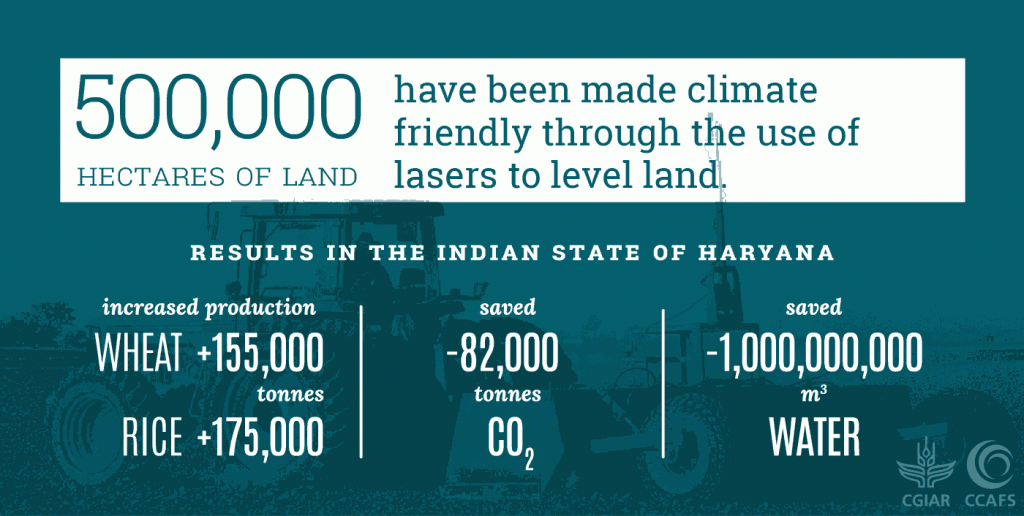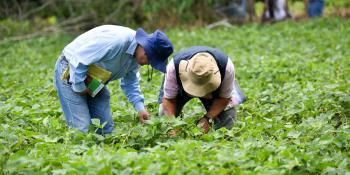Laser land levelling: How it strikes all the right climate-smart chords

Laser land levelling, a simple operation to prepare the land before sowing, can reap massive returns such as increasing yields, saving water and reducing greenhouse gas emissions.
Life in rural India evokes an image of a farmer levelling the land with an oxen-drawn scraper. It is one of the most basic and integral farm preparations before sowing. Undulated land does not bode well for water absorption and farm productivity.
But for many farmers animal power is being replaced by machines. A laser land leveller- a machine equipped with a laser guided drag bucket- is much more effective and quicker in ensuring a flat table-top like surface. An even land means irrigation water reaches every part of the field with minimal waste from run-off or water-logging.
While mechanisation is good news to farmers, climate change and climate variability pose unprecedented challenges to agriculture. We need climate-smart agriculture practices and technologies that save on scarce resources like water and energy but increase yields, incomes and reduce environmental footprints. When practised together, a portfolio of climate-smart practices can equip farmers to adapt to changing weather patterns amidst depleting natural resources. For instance, groundwater in north-western India has been declining at alarming rates because of the overuse of electric pumps, largely by subsidised electricity, and inadequate recharge from erratic rainfall. Recent studies predict that there would be at least a 10 percent increase in irrigation water demand with a 1 °C rise in temperature in arid and semi-arid regions of Asia. Irrigation is the biggest user of groundwater in north-western India and unless steps are taken to revert this trend, farmers are looking at a water-scarce future.
A study, Impacts of Laser Land Leveling in Rice-Wheat Systems of the North–western Indo-Gangetic Plains of India, by researchers from the International Maize and Wheat Improvement Centre (CIMMYT), Borlaug Institute for South Asia (BISA) and the CGIAR Research Program on Climate Change, Agriculture and Food Security (CCAFS) looks into the impact of laser land levelling in rice-wheat systems in north India. The study aims to assess if and how laser land levelling helps farm communities by improving farm productivity, saving on water and energy, reducing greenhouse gas emissions and increasing incomes.
Using household surveys and comparing data from traditional levelling, the study comes up with key research findings that show the benefits behind laser land levelling but also the policy implications of promoting new climate-smart technologies among farmers.
Key findings:
- Laser land levelling considerably lowers irrigation time for rice by 47-69 hours per hectare per season and for wheat by 10-12 hours per hecate per season.
- It increases yields by an average 8 percent for both crops.
- It saves electricity about 755 kWh per hectare per year for rice-wheat systems.
- It's cost effective. As demand increases, service providers rent out equipment and farmers collectively share the costs.
- A study showed that it reduces greenhouse gas emissions from saving on energy, reducing cultivation time and increasing input efficiency.
- Higher yeilds means higher incomes for farmers.
How it helps
Irrigation time: Laser-levelling in rice fields reduced irrigation time by 47-69 hours per hectare per season and improved yield by approximately 7 percent compared with traditionally levelled fields. In wheat, irrigation time was reduced by 10-12 hours per hectare every season and yield increased by 7-9 percent in laser levelled fields.
Food security: Based on analysis from the data, the study computes that if 50 percent of the area under rice-wheat systems in Haryana and Punjab states were laser levelled, it would result in an additional production of 699 million kg of rice and 987 million kg of wheat which amounts to USD 385 million a year extra. Not only does this translate to higher incomes for farmers but it also increases food security of the region given that the Indo-Gangetic Plains are a bread basket and rice bowl in South Asia.
Energy: Less time spent on irrigation means less energy spent on irrigation. The study shows that laser land levelling saves electricity amounting to about 755 kWh per hectare per year for rice-wheat systems.
Costs: Another perception that the study challenges is that only large-holder or rich farmers can afford and benefit from laser-levellers. In fact, laser land levelling is scale neutral and not particularly biased towards large-holdings. It is common for many small-holder farmers to rent the equipment or form a cooperative to share the costs. The rental cost is about USD10 for an hour. It takes about 4 to 5 hours to laser level a hectare of land and the farmers need to do it once in 3 years.
View a video on farmers speaking about laser-land levelling
Water: Laser land levelling is essentially a water-saving technology as it uses scarce groundwater optimally by ensuring even coverage. Compared to traditionally levelled land, a laser levelled farm minimises run-off and water-logging ensuring that farmers use just as much water they need in the best possible way.
Less greenhouse gas emissions: A related study (Jat et al 2015) reported that use of laser land leveller over traditional land levellers reduces emission of greenhouse gases through decreased water pumping time, decreased cultivation time and better use of fertilizers.
Income: The increased yields and the money saved on water and energy means farmers benefited by an additional USD 143.5 per hectare a year from growing rice and wheat.
Policy implications
Laser land levelling is just one among numerous farming activities that contribute to sustainable agriculture. When used in combination with other resource-saving practices and technologies like solar energy based irrigation, precision nutrient application, direct-seeded rice, zero tillage and proper residue management, the gains can be multiplied for each farmer and the community as a whole.
As a single farm intervention, however, the evidence from the study shows the benefits call for investigating business models that can increase uptake of this technology as help scaling other technologies in different landscapes and socio-economic settings.
Governments need to assess how they can support farming communities take up new technologies that deliver multiple benefits. The aim should also be to ensure that technology uptake is inclusive and does not discriminate against marginalised farmers.
This blog was originally published on The Financial Express: Towards climate-friendly farms
Read more:
- Thomson Reuters Foundation: Laser technology to level farm land saves water and energy
- Annual Report: Half a million hectares made ‘climate friendly’ through laser land levelling
This article was written by Dharini Parthasarathy, CCAFS South Asia Communications Specialist




